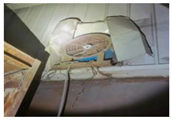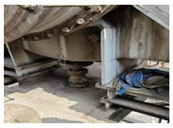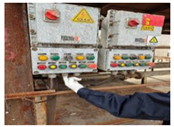Abstract
There is a lack of a quantitative assessment of the risk factors associated with poisoning and asphyxiation accidents in steel enterprises, especially the insufficient treatment of uncertainty in risk analysis. To address this issue, this work proposed a risk assessment method based on fuzzy Bayesian network (FBN), which established a risk assessment indicator system for poisoning and asphyxiation from four aspects, including human, material, environmental, and management factors, and illustrated the relationship between these risk factors through fault tree analysis (FTA). Taking a steel plant in China as an example, fuzzy set theory (FST) and expert surveys were combined to determine the prior probabilities and conditional probabilities of Bayesian network (BN) nodes. The results show that (i) the probability of poisoning and asphyxiation accidents in this steel plant is 74%; (ii) among the various influencing factors, defective or inadequate monitoring and alarm devices, isolation devices, equipment inspection systems, and toxic gas operation management are identified as the critical contributors; and (iii) this accident probability has decreased to 47% after rectification measures and reassessment. The findings of this research offer valuable insights for steel enterprises in preventing poisoning and asphyxiation accidents.
1. Introduction
Steel, as an indispensable basic material in modern society, is widely used in many key areas such as construction, automobiles, machinery, and energy, and its demand continues to remain high. Steel enterprises are industrial enterprises that mine, treat, smelt, or process ferrous metal ores into materials. Steel enterprises manufacture various products, including plates, profiles, tubes, and special steels. Although their production processes and product characteristics differ, they all face similar health and safety risks. In China, the steel industry is not only a pillar of the national economy but also an important force in promoting the process of industrialization, which contributes to economic growth and employment. Steel production is a high-risk industry because it is highly susceptible to safety accidents due to the inherent dangers of high temperatures, gas operations, and harsh working environments during the production process. Carrying out a safety risk assessment of typical accidents in steel enterprises is of great significance in promoting the transformation of safety risk management from after-the-fact rescue to before-the-fact.
Numerous scholars have undertaken progressive research into the safety management models and methodologies of steel enterprises. Based on resource eco-economics and eco-industry theory, a risk source model was established to analyze the risk factors in the production process of Chinese steel enterprises [1]. The relevant researchers comprehensively evaluated the health risks associated with occupational exposure to heavy metals within steelmaking installations of Iran steel plants [2]. Scholars analyzed historical accident data from steel enterprises and used hierarchical analysis and gray theory to construct an accident warning model for Chinese steel enterprises, validated through a case study [3]. Meanwhile, other researchers used the failure mode and effects analysis (FMEA) and risk priority number (RPN) to analyze risk factors in the Yazd steel plant’s departments, identifying hazardous activities and proposing improvement strategies [4]. Scholars used the fuzzy evaluation method combining the entropy weight method (EWM) and the ordinal relationship method (ORM) to establish a risk evaluation system for toxic gas leakage and assessed the overall condition of the Chinese metallurgical plant as “excellent” [5]. It can be seen that there are relatively few papers on the disaster risk assessment of typical accidents in steel enterprises.
Among traditional risk analysis methods, the Bayesian network (BN) is an effective causal analysis tool for uncertain knowledge in probabilistic systems [6]. As an analytical tool, BN can be combined with other analytical methods (bow-tie method, fault tree method, fuzzy theory, etc.), which can be used to perform risk analysis under conditions of imperfect historical data and make the assessment more effective in accident analysis [7,8,9]. Therefore, the BN model is widely used for risk analysis in various fields. Fuzzy logic was incorporated into the BN used for the safety assessment of oil and gas pipelines, and the most significant causes of oil and gas pipeline failures were found [10]. Researchers proposed a methodology to analyze Arctic shipping accident scenarios using BN and identified the most important causal factors for potential accident scenarios [11]. Combining the similarity aggregation method with the BN model resulted in more accurate and reliable tank accident prediction results [12]. BN is suitable for analyses with insufficient data information and many indicator factors that require probabilistic analysis and explanation of the inference process. Its shortcomings are that it needs to obtain part of the data with the help of subjective evaluation, which reduces the rigor and has complex analytical calculations. Overall, BN is an effective and widely used method for risk analysis.
In this work, a targeted risk assessment model for accidents in steel enterprises was proposed, integrating fault tree analysis (FTA) with fuzzy Bayesian network (FBN) methodology, to realize the quantitative assessment of this risk. A case study was carried out on a steel plant where forward and backward reasoning and sensitivity analysis were used to predict the probability of accidents, identify critical influencing factors, and suggest improvement measures.
2. Methodology
2.1. Statistics of Accidents in Steel Enterprises
The analyzed accident data are primarily sourced from the official website of China’s Ministry of Emergency Management. The time frame for these accidents spans from 1 January 2010 to 31 December 2023. This work focused on accidents involving steel enterprises, with accident levels designated as larger or above, as classified according to the ‘Regulations on Reporting and Investigation of Production Safety Accidents’. After rigorous screening and organization, 85 valid accident cases that met this study’s criteria were ultimately selected for analysis.
The 85 selected accidents for analysis were systematically categorized by the ‘Classification for Casualty Accidents of Enterprise Employees’ (GB 6441-1986) [13]. Table 1 presents the poisoning and asphyxiation accidents in some Chinese steel enterprises. Figure 1 presents the analysis outcomes regarding the types of safety accidents in Chinese steel enterprises. As can be seen, when categorized by frequency, poisoning and asphyxiation accidents (39 cases) emerge as the most prevalent, followed by other explosions (13 cases), and burning hot (8 cases). Similarly, in terms of fatalities and injuries, these three accident types also rank among the top. This suggests that poisoning and asphyxiation accidents pose the most significant threat to the production process of steel enterprises. The main reasons for this are the frequent use of gas equipment and the risk of leakage, as well as the combined effects of poor operational management, low employee safety awareness, and poor ventilation in the operating environment. These factors lead to the accumulation of toxic and hazardous gases in the work area, increasing the risk of poisoning and asphyxiation. Therefore, steel enterprises must prioritize identifying and mitigating the risk factors that lead to such accidents in their production safety management.

Table 1.
Poisoning and asphyxiation accidents in some Chinese steel enterprises. (From the accident report posted on the official website of China’s Ministry of Emergency Management).
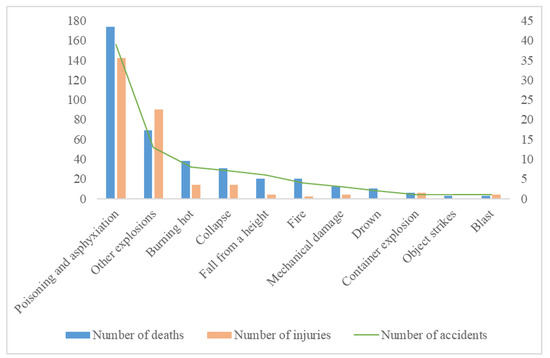
Figure 1.
Statistical analysis regarding types of safety accidents in Chinese steel enterprises, 2010–2023. (Data from the official website of China’s Ministry of Emergency Management).
2.2. Research Framework
To comprehensively evaluate the risk of poisoning and asphyxiation in steel enterprises, this work proposed a risk assessment model that integrated FTA and FBN. Figure 2 presents the research framework employed in this work. The model leverages the fault tree (FT) to deeply explore the logical relationships between risk factors and subsequently maps them onto a BN. This approach not only enhances the inference efficiency but also improves the model’s dynamic updating capabilities. Furthermore, the introduction of FST strengthens the objectivity of the assessment results.
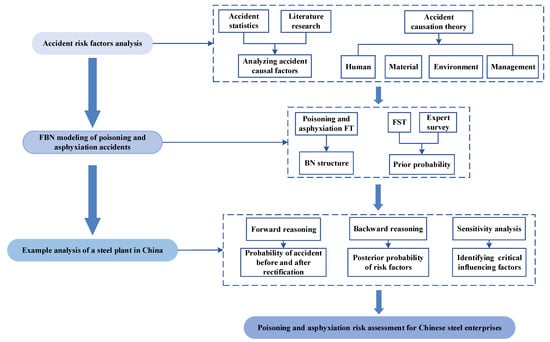
Figure 2.
Framework for analyzing poisoning and asphyxiation accidents in Chinese steel enterprises.
2.3. Fault Tree of the Poisoning and Asphyxiation Accidents
FT is a specialized form of tree logic diagram that utilizes intuitive graphics to elucidate the underlying mechanisms of system failures. By integrating specified events, logic gates, and symbols, it effectively depicts the various causal relationships within a system [14]. Based on the investigation reports of 39 poisoning and asphyxiation accidents collected, the causes of accidents with a high frequency of occurrence were distilled as the basic causal elements leading to accidents. An in-depth analysis of the accident risk factors in steel enterprises was conducted, considering four critical aspects, namely, human, material, environmental, and management, under the guidance of the accident causation theory. Additionally, the risk factors specific to poisoning and asphyxiation accidents were identified by integrating the ‘Classification for Casualty Accidents of Enterprise Employees’ (GB 6441-1986) and the ‘Guidance Manual for Identification and Prevention of Larger Hazardous Factors in Metallurgical Industry’. Table 2 presents the risk factors for poisoning and asphyxiation accidents. Figure 3 presents the poisoning and asphyxiation FT to further characterize the relationships between these risk factors.

Table 2.
Risk factors for poisoning and asphyxiation accidents.
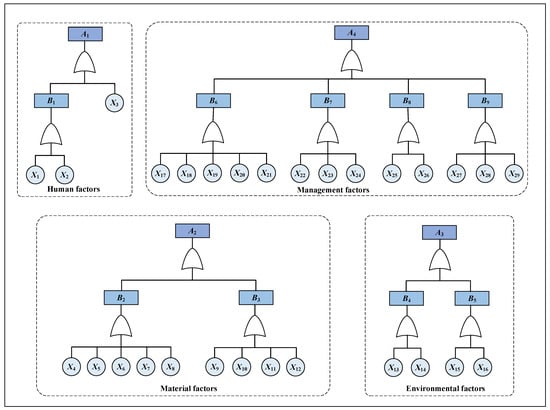
Figure 3.
Poisoning and asphyxiation FT.
2.4. Bayesian Network
- (i)
- Bayesian network fundamentals
BN, a directed acyclic graph (DAG) incorporating probabilistic analysis and graph theory, was extensively utilized in constructing security models that relied on uncertain knowledge [15]. In BN, nodes represent variables, while directional arrows depict direct causal relationships between interconnected nodes. The arrows point to the child nodes from the parent nodes, and the conditional probability tables (CPTs) assigned to the nodes indicate the dependencies between them [16,17]. BN has proven to be an efficacious approach to risk assessment, particularly in scenarios where data availability is limited [7,18]. BN facilitates both forward and backward reasoning by propagating evidence across the network and updating probabilities, thus identifying crucial influences that are vital to overall safety [19].
Assuming that there exists m mutually independent parent nodes Xi1, Xi2, …, Xij, …, Xim for the child node Xi in the BN, the probability of Xi can be expressed as:
where P(Xi) is the probability of the child node Xi, P(Xi∣Xij) is the probability of Xi occurring given that the parent node Xij has occurred, and P(Xij) is the probability of the parent node Xij.
When P(Xi) changes, perform backward reasoning to calculate the posterior probability of each node:
- (ii)
- Transforming fault tree into Bayesian network
In the realm of risk assessment using BN, numerous experts employed a technique that involved mapping FT onto BN [20,21,22,23,24]. This approach leverages the FT’s proficiency in combining the logical relationships between risk factors while fully harnessing the deductive reasoning strengths of BN. The resulting network structure is designed to exhibit dynamic characteristics, enabling it to update the occurrence probabilities of basic events promptly based on the input of new data. The correspondence of an FT to a BN and the logic gate conversion are shown in Figure 4 and Figure 5 [25]. The mapping of FT to BN has the following main steps.
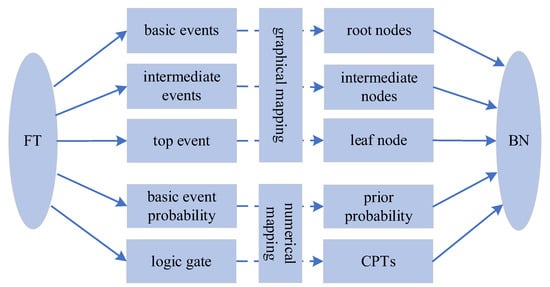
Figure 4.
Correspondence to convert an FT to a BN.
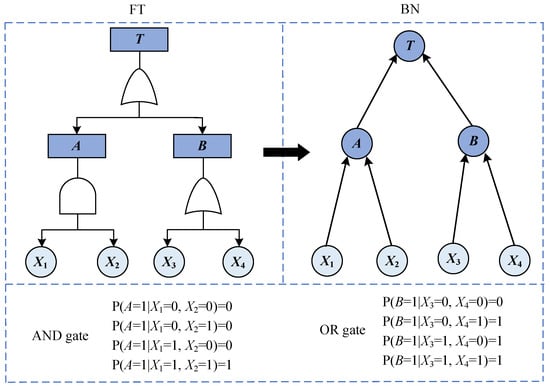
Figure 5.
Conversion of the AND gate and OR gate.
Structure mapping: Each event in the FT (including the bottom event, intermediate event, and top event) is mapped to a node in a BN. Among them, the bottom event (basic event) is converted to the root node of the BN; the intermediate event is converted to the middle node of the BN; and the top event is converted to the leaf node of the BN.
Probability mapping: According to the logical relationship between the events in the FT (e.g., “and gate” and “or gate”), the corresponding CPT is established in the BN.
2.5. Fuzzy Set Theory
FST, introduced by the eminent scholar Zadeh [26], has demonstrated significant advantages and applicability in tackling complex and uncertain problems. Since risk factors in the actual production environment are often ambiguous and uncertain, the description of risk levels such as “low”, “medium”, “high”, etc., often relies on the subjective judgment and empirical knowledge of experts. Fuzzy theory can effectively deal with this kind of ambiguity by defining fuzzy sets and fuzzy rules and transforming the fuzzy language of experts into numerical model parameters, to realize the quantification of risk factors. Various fuzzy number forms have existed, including trapezoidal, normal, and triangular fuzzy numbers. Triangular fuzzy numbers were commonly employed to furnish a relatively precise description of uncertainty and yield plausible outcomes [27]. Consequently, for the sake of computational convenience, this work employed the triangular fuzzy number as a functional representation to describe the node failure rate.
- (i)
- Triangular fuzzy numbers
In FST, considering an argument domain U, for any element x belonging to U, there exists a corresponding value F(x) ranging from 0 to 1. This F represents a fuzzy set on U, where F(x) signifies the degree of affiliation of x to F. Specifically, the triangular affiliation function can be formulated as follows. By definition, its membership function is:
where a is the minimum possible value of the node state, b is the most likely value of the node state, and c is the maximum possible value of the node state.
- (ii)
- Natural Language Variables
Seven fuzzy linguistic scales were defined to describe the failure probability of basic events [28,29]. Table 3 presents the correlation between these natural language variables and triangular fuzzy numbers.

Table 3.
Correlation between natural language variables and triangular fuzzy numbers.
- (iii)
- Expert scoring weights
Given the variations in expertise across different domains, the two critical influencing factors of expertise disparities, namely, ‘education’ and ‘years of experience’, were selected [9,16,25]. Table 4 presents the expert scoring weights. The experts’ opinions are processed accordingly using Formula (4).
where αk is the weight of the kth expert’s education, βk is the weight of the kth expert’s years of experience, is the triangular fuzzy value transformed by the kth expert’s linguistic description of the probability of the node’s occurrence, and P is the fuzzy value after synthesizing the expert’s opinion on the node.

Table 4.
Expert scoring weights.
- (iv) Defuzzification
Defuzzification is the process of producing quantifiable results in fuzzy logic using Formula (5) [30]:
- (v) Fuzzy probability
The last step is to convert the fuzzy possibility (FPS) of the fuzzy event into fuzzy probability (FPR). Formula (6) is employed to convert the FPS to the FPR [31].
where K is a constant value, FPS is the fuzzy possibility, and FPR is the fuzzy probability of each node.
3. Case Study
3.1. Case Background
Baotou Iron and Steel (Group) Co., Ltd. in Inner Mongolia Autonomous Region of China was established in 1954, after 70 years of development, it has become the world’s largest rare earth industrial base and China’s important iron and steel industrial base, with two listed companies, Baotou Iron and Steel Co., Ltd. and Baotou Rare Earth Co., Ltd. in Inner Mongolia Autonomous Region of China. This work conducted a risk assessment of a steel plant under the Baosteel Group in 2023. The steel plant encompasses two steelmaking continuous casting operation zones and a raw material operation zone. Three production process flows are in operation: iron pre-treatment, converter, and continuous casting; iron pre-treatment, converter, refining, and continuous casting; and iron pre-treatment, converter, refining, vacuum degassing (VD), and continuous casting. Throughout these processes, various potential risks, including poisoning, asphyxiation, burns, explosions, electric shock, and fires, may arise due to various factors such as operational errors, equipment failures, and natural phenomena. If these risks are not adequately managed, they can easily result in casualties and property damage.
The developed assessment model was utilized to analyze the risk of poisoning and asphyxiation accidents within the steel plant. To ensure the assessment’s accuracy and comprehensiveness, a field study was conducted with six steel industry safety management experts. The experts thoroughly examined the plant, identifying and documenting hidden hazards by the standards and regulations of the steel industry. This work revealed numerous hidden hazards. Table 5 presents a selection of these hazards.

Table 5.
The steel plant site assessment of some hidden hazards.
3.2. Bayesian Network Modeling of Poisoning and Asphyxiation Accidents
- (i)
- Node probability calculation
The prior probability is the probability of an event occurring based on statistical data or empirical analysis [32]. To determine the prior probabilities of the root nodes, the opinions of six experts were solicited, who were tasked with evaluating the occurrence (True) status of the bottom event in the poisoning and asphyxiation accidents depicted in Figure 3. In this work, the impact of the experts’ educational backgrounds and years of relevant industry experience on the accuracy of the assessment was taken into account. Table 6 presents the experts’ information and their respective weight allocation. Table 7 presents the results of the analysis, using Formulas (4)–(6).

Table 6.
Expert information and weighting.

Table 7.
The expert fuzzy evaluation and comprehensive calculation result of the root nodes.
The probabilities of the intermediate nodes are determined by the CPT generated by the logical gate assignment in the FTA model. Taking intermediate node B4 (poor production work environment) as an example, Figure 3 shows that B4 is associated with its parent nodes X13 (poor lighting in the work area) and X14 (poor ventilation of production sites) as ‘or’ gates. According to the logic gate mapping algorithm depicted in Figure 5, the conditional probabilities of the intermediate node B4, P (B4 = True|X13 = True, X14 = True), P (B4 = True|X13 = True, X14 = False), and P (B4 = True|X13 = False, X14 = True), are all 1, and P (B4 = True|X13 = False, X14 = False) has a value of 0. B4 was found based on Formula (1):
- (ii)
- Forward reasoning
Forward reasoning refers to the process of determining the probability of a risk event occurring in a given state, where the risk factors are already identified, utilizing the conditional probability distribution among the nodes. The probability for all intermediate and leaf nodes was calculated using the above process, and these data were then inputted into the Genie 2.3 software.
Figure 6 shows the forward reasoning results of poisoning and asphyxiation accidents in the steel plant. It can be found that the probability of poisoning and asphyxiation accidents occurring in the steel plant stands at 74%, highlighting the potential risk associated with such accidents.

Figure 6.
Forward reasoning analysis of poisoning and asphyxiation accidents in the steel plant.
- (iii)
- Backward reasoning
Backward reasoning involves the calculation of the posterior probability of each root node based on the conditional probability distribution among the nodes under the known occurrence of a risk event. In this work, with the assumption that the poisoning and asphyxiation accidents have occurred in the steel plant, the probability of the target node T (poisoning and asphyxiation accidents) was set to 100%. By applying backward reasoning, the posterior probability of each node was obtained.
Figure 7 presents the prior and posterior probability of root nodes. It can be found that five risk events have a particularly significant impact on poisoning and asphyxiation accidents in the steel plant. These are X9 (defective monitoring and alarm devices), X2 (operating errors and ignoring warnings), X19 (inadequate equipment inspection management systems), X28 (inadequate safety management of toxic and hazardous gas operations), and X4 (defective gas pipe isolation devices). All of these risk events have posterior probabilities exceeding 12%. Therefore, it is essential to focus on these five risk events, prioritize the development of stringent improvement measures, and reduce the probability of these five risk events occurring.
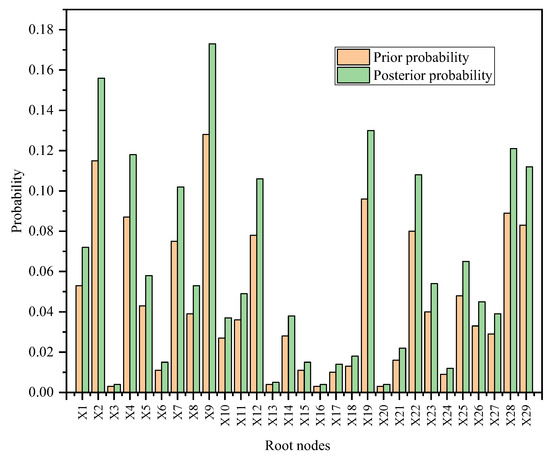
Figure 7.
The prior probability and posterior probability of root nodes.
- (iv) Sensitivity analysis
Sensitivity analysis serves as a method to identify crucial factors contributing to accidents by assessing the degree of influence that other nodes have on the target node. Here, a sensitivity analysis was conducted on node T (poisoning and asphyxiation accidents) to identify the critical factors leading to such accidents.
Figure 8 presents the outcomes of the sensitivity analysis of partial root nodes for poisoning and asphyxiation accidents. It can be found that several risk factors significantly influence the prevention of poisoning and asphyxiation in the steel plant. Specifically, X9 (defective monitoring and alarm devices), X2 (operating errors and ignoring warnings), X19 (inadequate equipment inspection management systems), X28 (inadequate safety management of toxic and hazardous gas operations), and X4 (defective gas pipe isolation devices) have been identified as major contributors, with their impact diminishing in the order stated. Therefore, attention should be focused on these five risk factors, and targeted prevention and control measures should be taken to ensure the safe and stable operation of the steel plant.
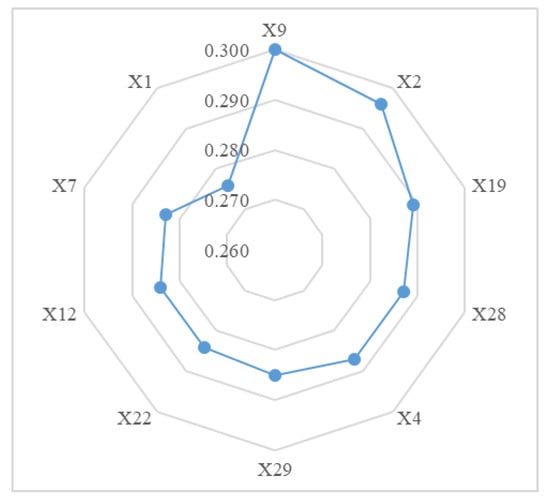
Figure 8.
Sensitivity analysis of partial root nodes for poisoning and asphyxiation accidents.
3.3. Probability of Accident after Rectification
The steel plant has accorded significant attention to the hidden hazards identified through the experts’ on-site investigation and has implemented corrective measures accordingly. Rectification is the process of eliminating or controlling the discovered potential safety hazards, through taking a series of effective measures to make the production environment, equipment and facilities, personnel behavior, etc., meet the requirements and standards of safe production. The rectification process usually includes the steps of identifying and evaluating potential hazards, formulating rectification programs, implementing rectification measures, and verifying the effects of rectification. Despite the fact that some hidden hazards involving complex factors such as management systems and fire-fighting equipment are difficult to fully rectify in a short period of time, the remaining hidden hazards have been basically addressed. Figure 9 presents the rectification status of some hidden hazards.
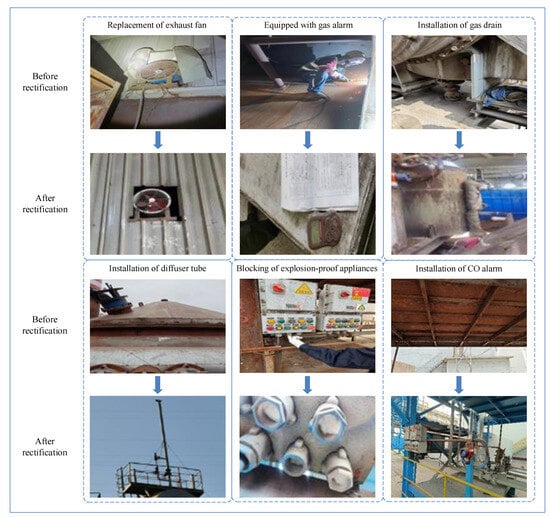
Figure 9.
Some of the rectified hazards in the steel plant.
To evaluate the effect of the rectification, the six experts were invited to conduct a survey and to score the steel plant again. Figure 10 presents the comparison of the prior probability of root nodes before and after rectification. According to the results of forward reasoning, the probability of poisoning and asphyxiation accidents has decreased to 47%. This significant decline not only underscores the effectiveness of the rectification work but also validates the reliability of the established assessment indicator.
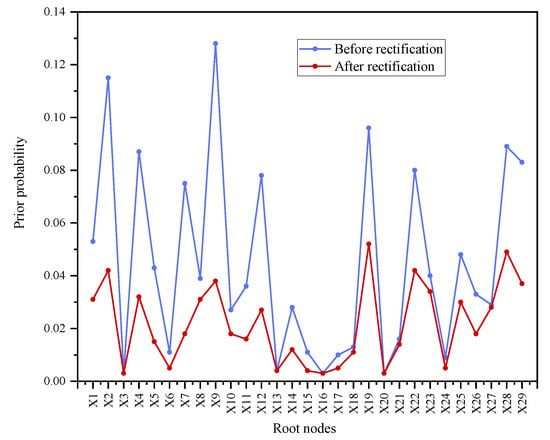
Figure 10.
The prior probability of root nodes before and after rectification.
The following recommendations were proposed for some of the critical influencing factors that contribute to poisoning and asphyxiation accidents in the steel plant.
Regarding operating errors and ignoring warnings: establish standardized procedures for recording and responding to alarm information, with corresponding emergency response plans based on alarm levels; organize regular safety training to ensure employees understand and master safety protocols and emergency handling measures.
For monitoring and alarm devices: locate them in potential toxic gas release areas such as pumps, valves, and unloading ports; arrange gas alarms reasonably with adequate spacing for comprehensive monitoring; establish a multi-tiered alarm mechanism with distinct levels including warnings, alarms, and emergency alarms; install the alarm controller independently from production process control instrumentation in a manned area.
To optimize equipment inspection management: establish a standardized inspection process with a comprehensive plan, schedule, and clear inspection content; strengthen training and oversight of inspection personnel, including a periodic evaluation mechanism; intensify preventive maintenance measures, including detailed files and maintenance records; implement real-time monitoring and analysis of equipment operating conditions.
4. Conclusions
This work established a risk assessment indicator system to quantify the probability of poisoning and asphyxiation accidents in a Chinese steel plant, identifying critical risk factors and significantly reducing accident risk through rectification measures. The main conclusions are as follows:
(i) A risk assessment indicator system was established for poisoning and asphyxiation accidents, encompassing human, material, environmental, and management factors, providing a framework that can be utilized for risk assessment in similar enterprises. The application of the FTA and FBN methodology to a steel plant in China provided a quantitative assessment of the probability of poisoning and asphyxiation accidents, which are found to be 74%.
(ii) Through a detailed analysis of the BN results, these critical risk factors that significantly contribute to the occurrence of poisoning and asphyxiation accidents were pinpointed. Among the various influencing factors, defective or inadequate monitoring and alarm devices, isolation devices, equipment inspection systems, and toxic gas operation management are identified as critical contributors to the high accident probability. This finding not only provides a direct target point for risk prevention and control in steel plants, filling the gap of the FBN assessment method in the field of accident risk research in steel enterprises, but also enriches the theoretical practice of industrial safety management and demonstrates the unique advantages of FBN in the risk assessment of complex systems.
(iii) The probability of poisoning and asphyxiation accidents decreased to 47% after rectification measures and reassessment. This significant decline not only underscores the effectiveness of the rectification work but also validates the reliability of the established assessment indicator. Considering the steel plant’s specific conditions, further risk prevention and control measures were proposed, including enhancing the inspection and maintenance of equipment, refining the safety management system, and intensifying employee safety training. It provides theoretical support and practical guidance for safety production in the steel industry.
(iv) The construction of the FBN model relies on a series of assumptions and prior knowledge, which may deviate from the actual situation and affect the accuracy of the assessment results. In addition, all possible risk factors, such as changes in the external environment, are not considered in the model, which may also lead to incomplete assessment results. Future research can explore how to integrate data from different channels, such as internal corporate monitoring data, industry reports, and government regulatory data, to improve the comprehensiveness and accuracy of risk assessment. At the same time, big data and machine learning technologies can be introduced to automatically identify and extract key risk factors and reduce the impact of human intervention and subjectivity.
Author Contributions
Data curation, Y.Y.; Formal analysis, Q.L.; Investigation, P.D.; Methodology, W.L. and Q.L.; Resources, Q.Y. and W.L.; Supervision, Q.Y. and W.L.; Validation, Q.L.; Writing—original draft, W.L.; Writing—review and editing, Q.L. and Q.Y. All authors have read and agreed to the published version of the manuscript.
Funding
This research was funded by the National Natural Science Foundation of China [grant number 52074303], the National Key Research and Development Program of China [grant number 2023YFC3009004], and the Fundamental Research Funds for the Central Universities [grant number 2024JCCXAQ03].
Data Availability Statement
The original contributions presented in the study are included in the article; further inquiries can be directed to the corresponding author.
Conflicts of Interest
The authors declare no conflicts of interest.
References
- Zhang, J. Risks and Risk Management in Chinese Iron and Steel Enterprises. Adv. Mater. Res. 2011, 201–203, 1061–1065. [Google Scholar] [CrossRef]
- Dehghani, F.; Omidi, F.; Fallahzadeh, R.A.; Pourhassan, B. Health Risk Assessment of Occupational Exposure to Heavy Metals in a Steel Casting Unit of a Steelmaking Plant Using Monte–Carlo Simulation Technique. Toxicol. Ind. Health 2021, 37, 431–440. [Google Scholar] [CrossRef] [PubMed]
- Li, C.; Qin, J.; Li, J.; Hou, Q. The Accident Early Warning System for Iron and Steel Enterprises Based on Combination Weighting and Grey Prediction Model GM (1, 1). Saf. Sci. 2016, 89, 19–27. [Google Scholar] [CrossRef]
- Ebrahemzadih, M.; Halvani, G.H.; Shahmoradi, B.; Giahi, O. Assessment and Risk Management of Potential Hazards by Failure Modes and Effect Analysis (FMEA) Method in Yazd Steel Complex. Open J. Saf. Sci. Technol. 2014, 4, 127–135. [Google Scholar] [CrossRef][Green Version]
- Kariman, K.; Gao, N.; Ma, C.; Wang, Z. A Risk Assessment System of Toxic Gas Leakages in Metallurgy Based on Fuzzy Evaluation with Comprehensive Weighting. Appl. Sci. 2022, 12, 5948. [Google Scholar] [CrossRef]
- George, P.G.; Renjith, V.R. Evolution of Safety and Security Risk Assessment Methodologies towards the Use of Bayesian Networks in Process Industries. Process Saf. Environ. Prot. 2021, 149, 758–775. [Google Scholar] [CrossRef]
- Wu, J.; Zhou, R.; Xu, S.; Wu, Z. Probabilistic Analysis of Natural Gas Pipeline Network Accident Based on Bayesian Network. J. Loss Prev. Process Ind. 2017, 46, 126–136. [Google Scholar] [CrossRef]
- Benallou, I.; Azmani, A.; Azmani, M. Evaluation of the Accidents Risk Caused by Truck Drivers Using a Fuzzy Bayesian Approach. Int. J. Adv. Comput. Sci. Appl. 2023, 14, 173–182. [Google Scholar] [CrossRef]
- Li, Y.; Han, L.; Ning, X.; Xu, Y. Fire Risk of Electric Bicycle Based on Fuzzy Bayesian Network. J. Phys. Conf. Ser. 2020, 1578, 012153. [Google Scholar] [CrossRef]
- Kabir, G.; Sadiq, R.; Tesfamariam, S. A Fuzzy Bayesian Belief Network for Safety Assessment of Oil and Gas Pipelines. Struct. Infrastruct. Eng. 2016, 12, 874–889. [Google Scholar] [CrossRef]
- Afenyo, M.; Khan, F.; Veitch, B.; Yang, M. Arctic Shipping Accident Scenario Analysis Using Bayesian Network Approach. Ocean Eng. 2017, 133, 224–230. [Google Scholar] [CrossRef]
- Guo, X.; Ji, J.; Khan, F.; Ding, L.; Yang, Y. Fuzzy Bayesian Network Based on an Improved Similarity Aggregation Method for Risk Assessment of Storage Tank Accident. Process Saf. Environ. Prot. 2021, 149, 817–830. [Google Scholar] [CrossRef]
- GB6441-86; Labor Protection Bureau, Ministry of Labor and Personnel. Classification for Casualty Accidents of Enterprise Employees. State Bureau of Standards: Beijing, China, 1986.
- Wang, F.; Zheng, P.; Dai, J.; Wang, H.; Wang, R. Fault Tree Analysis of the Causes of Urban Smog Events Associated with Vehicle Exhaust Emissions: A Case Study in Jinan, China. Sci. Total Environ. 2019, 668, 245–253. [Google Scholar] [CrossRef] [PubMed]
- Martín, J.E.; Rivas, T.; Matías, J.M.; Taboada, J.; Argüelles, A. A Bayesian Network Analysis of Workplace Accidents Caused by Falls from a Height. Saf. Sci. 2009, 47, 206–214. [Google Scholar] [CrossRef]
- Bi, Y.; Wang, S.; Zhang, C.; Cong, H.; Gao, W.; Qu, B.; Li, J. A Bayesian Network-Based Safety Assessment Method for Solid Propellant Granule-Casting Molding Process. J. Loss Prev. Process Ind. 2023, 83, 105089. [Google Scholar] [CrossRef]
- Li, X.; Chen, G.; Zhu, H. Quantitative Risk Analysis on Leakage Failure of Submarine Oil and Gas Pipelines Using Bayesian Network. Process Saf. Environ. Prot. 2016, 103, 163–173. [Google Scholar] [CrossRef]
- Zhang, L.; Wu, S.; Zheng, W.; Fan, J. A Dynamic and Quantitative Risk Assessment Method with Uncertainties for Offshore Managed Pressure Drilling Phases. Saf. Sci. 2018, 104, 39–54. [Google Scholar] [CrossRef]
- Argenti, F.; Landucci, G.; Reniers, G.; Cozzani, V. Vulnerability Assessment of Chemical Facilities to Intentional Attacks Based on Bayesian Network. Reliab. Eng. Syst. Saf. 2018, 169, 515–530. [Google Scholar] [CrossRef]
- Bobbio, A.; Portinale, L.; Minichino, M.; Ciancamerla, E. Improving the Analysis of Dependable Systems by Mapping Fault Trees into Bayesian Networks. Reliab. Eng. Syst. Saf. 2001, 71, 249–260. [Google Scholar] [CrossRef]
- Boudali, H.; Dugan, J.B. A New Bayesian Network Approach to Solve Dynamic Fault Trees. In Proceedings of the Annual Reliability and Maintainability Symposium, 2005. Proceedings, Alexandria, VA, USA, 24–27 January 2005; IEEE: Piscataway, NJ, USA, 2005; pp. 451–456. [Google Scholar]
- Khakzad, N.; Khan, F.; Amyotte, P. Safety Analysis in Process Facilities: Comparison of Fault Tree and Bayesian Network Approaches. Reliab. Eng. Syst. Saf. 2011, 96, 925–932. [Google Scholar] [CrossRef]
- Marsh, W.; Bearfield, G. Representing Parameterised Fault Trees Using Bayesian Networks. In Computer Safety, Reliability, and Security; Saglietti, F., Oster, N., Eds.; Lecture Notes in Computer Science; Springer Berlin Heidelberg: Berlin/Heidelberg, Germany, 2007; Volume 4680, pp. 120–133. ISBN 978-3-540-75100-7. [Google Scholar]
- Montani, S.; Portinale, L.; Bobbio, A.; Codetta-Raiteri, D. Radyban: A Tool for Reliability Analysis of Dynamic Fault Trees through Conversion into Dynamic Bayesian Networks. Reliab. Eng. Syst. Saf. 2008, 93, 922–932. [Google Scholar] [CrossRef]
- Li, L.; Xu, K.; Yao, X.; Chen, S. Probabilistic Analysis of Aluminium Production Explosion Accidents Based on a Fuzzy Bayesian Network. J. Loss Prev. Process Ind. 2021, 73, 104618. [Google Scholar] [CrossRef]
- Zadeh, L.A. Fuzzy Sets. Inf. Control 1965, 8, 338–353. [Google Scholar] [CrossRef]
- Li, P.; Chen, G.; Dai, L.; Zhang, L. A Fuzzy Bayesian Network Approach to Improve the Quantification of Organizational Influences in HRA Frameworks. Saf. Sci. 2012, 50, 1569–1583. [Google Scholar] [CrossRef]
- Yazdi, M.; Kabir, S. A Fuzzy Bayesian Network Approach for Risk Analysis in Process Industries. Process Saf. Environ. Prot. 2017, 111, 507–519. [Google Scholar] [CrossRef]
- Li, M.; Wang, D.; Shan, H. Risk Assessment of Mine Ignition Sources Using Fuzzy Bayesian Network. Process Saf. Environ. Prot. 2019, 125, 297–306. [Google Scholar] [CrossRef]
- Mohamed, M.; Tran, D.Q. Risk-Based Inspection for Concrete Pavement Construction Using Fuzzy Sets and Bayesian Networks. Autom. Constr. 2021, 128, 103761. [Google Scholar] [CrossRef]
- Onisawa, T. An Approach to Human Reliability in Man-Machine Systems Using Error Possibility. Fuzzy Sets Syst. 1988, 27, 87–103. [Google Scholar] [CrossRef]
- Huang, Y.; McMurran, R.; Dhadyalla, G.; Peter Jones, R. Probability Based Vehicle Fault Diagnosis: Bayesian Network Method. J. Intell. Manuf. 2008, 19, 301–311. [Google Scholar] [CrossRef]
Disclaimer/Publisher’s Note: The statements, opinions and data contained in all publications are solely those of the individual author(s) and contributor(s) and not of MDPI and/or the editor(s). MDPI and/or the editor(s) disclaim responsibility for any injury to people or property resulting from any ideas, methods, instructions or products referred to in the content. |
© 2024 by the authors. Licensee MDPI, Basel, Switzerland. This article is an open access article distributed under the terms and conditions of the Creative Commons Attribution (CC BY) license (https://creativecommons.org/licenses/by/4.0/).
